9 Best Office Plants For Oxygen + Care Guide
- Updated on: January 24, 2025
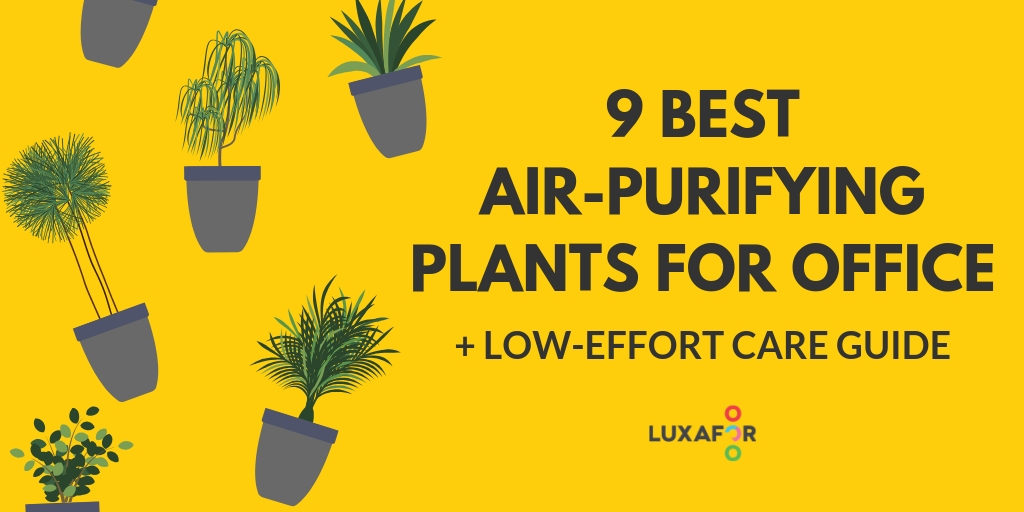
Welcome to Luxafor, your one-stop shop for conquering the ever-elusive realm of productivity. We understand the constant struggle to streamline your workflow, achieve goals, and tame the ever-growing to-do list. Whether you’re a seasoned professional, a student overwhelmed by deadlines, or simply someone seeking to optimize your daily routine, Luxafor is here to empower you.
You probably know that plants are awesome to make your office space a happier place, but did you know they can boost your productivity as well? Because of their air-purifying qualities they reduce CO2 levels, detox, and freshen up the air, creating a kick-ass environment for you to smash through your to-do list.
It’s a good idea to stock up on these green friends from many perspectives, especially for the sake of your own health. NASA, in their Clean Air Study, found that there are certain plants that are efficient in purifying indoor air from benzene, formaldehyde, ammonia, and other chemical compounds.
These chemicals are responsible for headaches and eye irritation, which are common symptoms of the sick-building syndrome (SBS), experienced by many employees around the world. The research suggests having at least one plant per 100 square feet of home or office space to benefit from their air-purifying capacities.
If you want to do your own little research on assessing the air quality in your office, make use of Luxafor CO2 Montior and evaluate the CO2 levels in order to know just how many plants you need around your desk to work in a healthier environment. Now that we’ve acknowledged the problem – air purifying plants for office which plants are the best for your workspace that are suitable for an office environments and are easy to care for?
Source: Luxafor
This extensive infographic by Love the Garden compiles the plants suggested by NASA.
However, not all of us are blessed with a green thumb. From NASA’s list, some of the plants are easy to care for, some are rather capricious – like Boston Fern and Kimberly Queen Fern (the name already suggests royal temper), and the Peace Lily, which recently passed away in our office despite our loving efforts (rest in Peace, Lily).
If you feel that some plants are dying on you, but you still want to make your office a prettier, healthier space, we’ve compiled the ultimate list of 9 best air-purifying plants for your office that are low-maintenance – complete with a care guide for you to see just how low-effort they really are.
1. Snake Plant
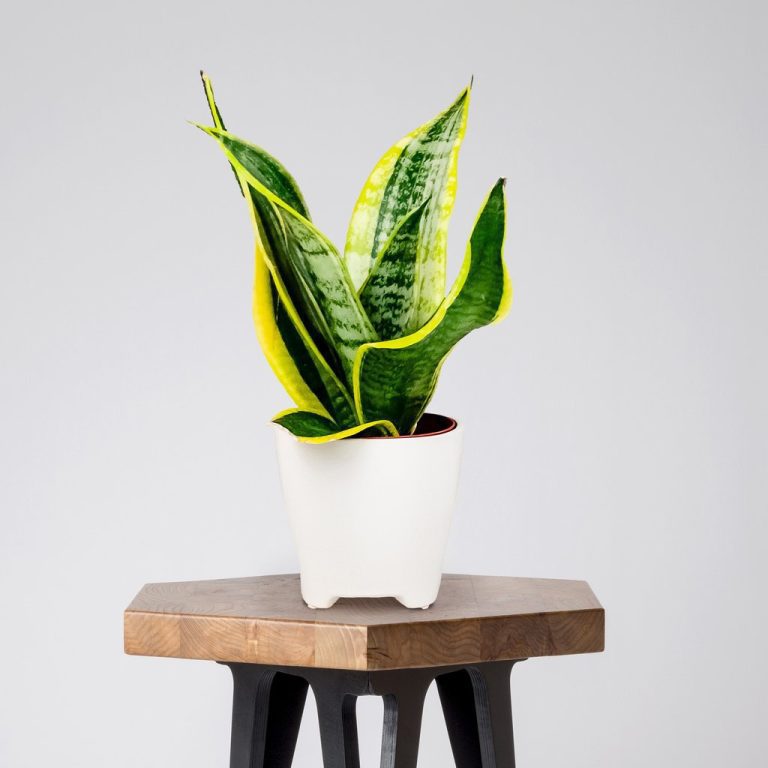
Source: Easy To Grow Bulbs
If plants had their own award ceremony, the award for the toughest would probably go to Snake Plant (Sansevieria). Not only do these plants remove toxins such as formaldehyde and benzene like a boss, but they’re also just as tough – you can neglect them for weeks and they’ll still look fabulous.
Also known as Mother-in-Law’s Tongue (we wonder where that association came from), the houseplant comes in 70 different species and is probably the best-potted plant choice for your office to maintain healthy air quality, while being low-maintenance.
Care guide:
Water moderately; endures drought – in fact, it’s better to let it dry out between waterings; loves indirect sunlight.
2. Red-edged Dracaena
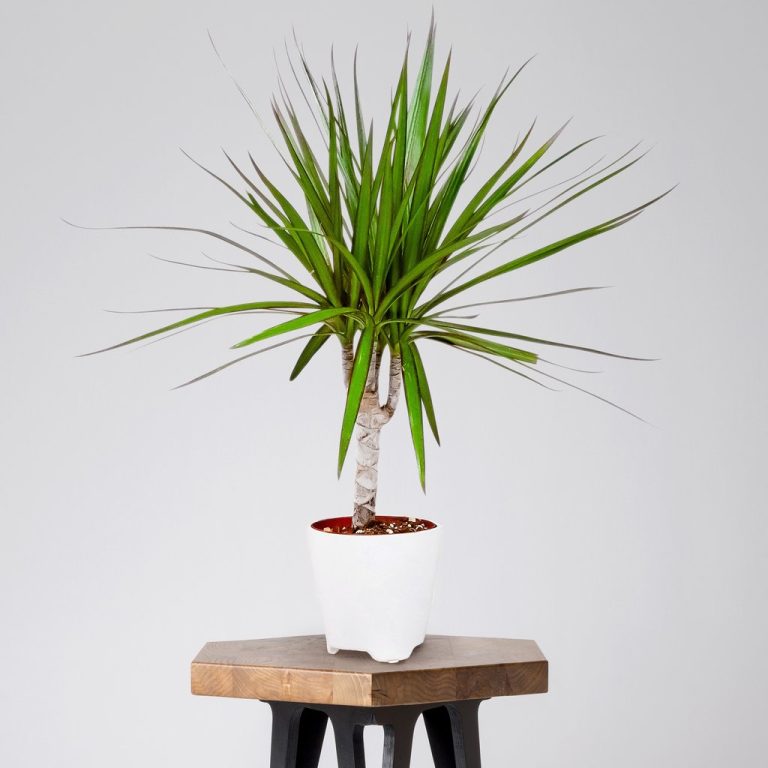
Source: Easy To Grow Bulbs
The tree-like plant dracaena is a great accessory to any office space, and caring for it, in fact, any dracaena variation, is fairly simple. However, the Red-edged Dracaena (Dracaena marginata) is specially selected by NASA due to its ultra-air-purifying properties. Not only the plant looks really charming with its often colorful strap-like foliage, but dracaena is also quite forgiving of temperatures, as long as they are not too cold.
Care guide:
Water moderately – keeping the soil moist, but never soggy; don’t fertilize it in fall and winter; locate it in bright filtered light, such as through a sheer curtain in front of a sunny window, at a room temperature of 60-70 °F.
3. Spider Plant
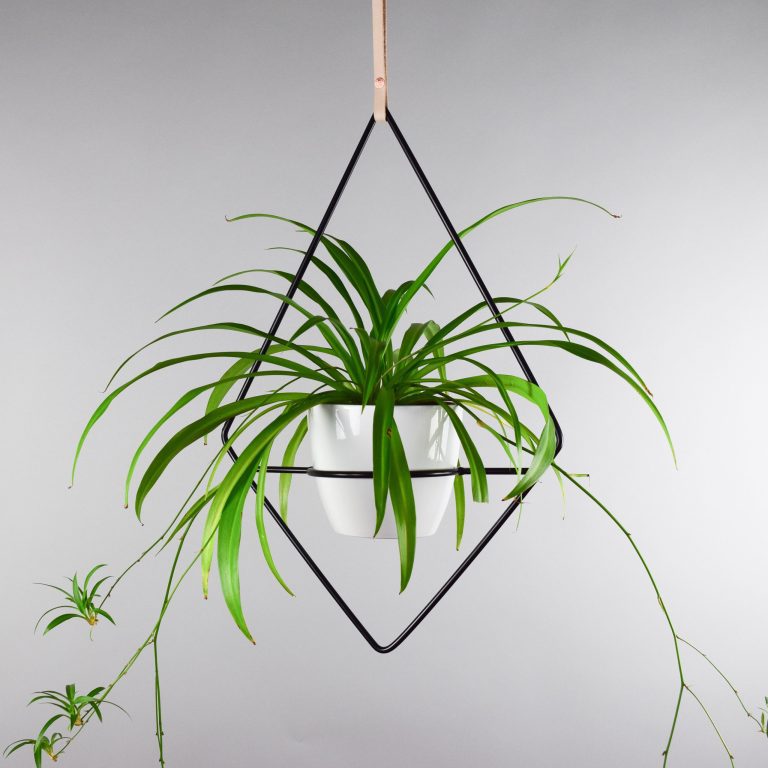
Source: Etsy
One of the most adaptable houseplants, the Spider Plant (Chlorophytum comosum), interestingly, got the name because of its spider-like plants, or spiderettes, which dangle down from the mother plant like spiders on a web. Besides their cool backstory, these plants enjoy their surroundings a bit on the cooler side, too. However, that’s probably their only fancy, as these plants can grow in a wide range of conditions and rarely suffer from something other than occasional brown tips.
Care guide:
Water moderately, keeping the soil moist, not soggy; let them dry out between waterings; loves bright, indirect light.
4. English Ivy

Source: House Beautiful
If you’re a fan of beautiful foliage and want to bring a bit of the outdoors inside, then English Ivy (Hedera helix) will make a wonderful plant for your office desk. It can grow long and lush, and it’s relatively easy to care for, provided you ensure one condition – lots of sunlight. Other than that, it’s super chill tolerating dry conditions – English Ivy even prefers to be left slightly dry, meaning there’s no need for you to water it frequently. English Ivy, and its many other varieties, will be a perfect addition to your workspace if you can place it somewhere near a window.
Care guide:
Water rarely, leave the soil a little dry (touch the top soil) before you water; loves bright light; fertilize once a month, if weak.
5. Dwarf Date Palm
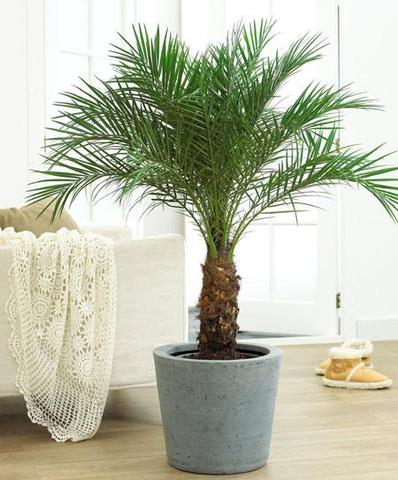
Source: Fast Growing Trees
If you’re longing for some tropical vibes, a great accent to make your workspace stylish is a palm. Although its name might imply otherwise, the Dwarf Date Palm (Phoenix roebelenii) is actually the biggest champion of the Arecaceae family when it comes to purifying the air.
Also known as Pygmy Date Palm, it grows very slowly, reaching a maximum height indoors of 4-5 ft. It favors indirect light, hence making it a beloved companion of folks at home and offices around the world. Besides, the Dwarf Date Palm doesn’t require an overly hot and humid environment as one might think – it does perfectly well at a normal room temperature of 50-75 F.
Care guide:
Water moderately, keeping the soil moist, not soggy; loves bright indirect light, but can survive in medium filtered light.
6. Bamboo Palm
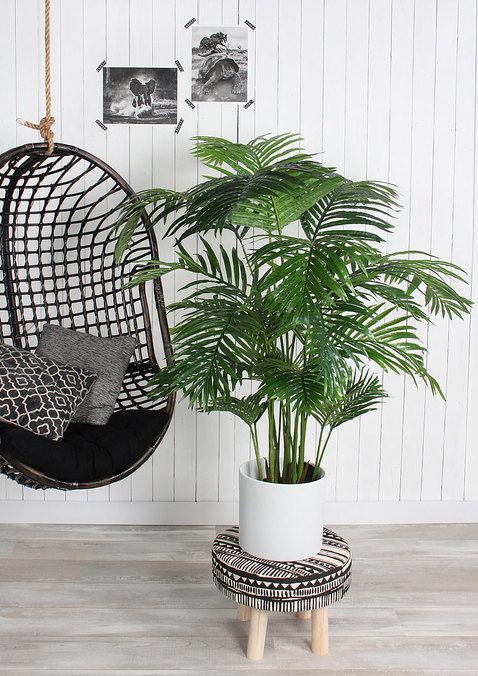
Source: Bakker
A spectacular addition to your office jungle is a Bamboo Palm – it brings so much color and warmth to any room and is surprisingly low-maintenance. While most tropical greens need bright indirect light to thrive, the Bamboo Palm (Chamaedorea seifrizii) will like that, while also being perfectly able to grow in low light conditions.
The plant goes by many names – Butterfly Palm, Golden Cane Palm, Areca Palm – and won’t probably take offense if you name it Keanu Leaves. It doesn’t mind anything, frankly, as it does well in normal indoor temperatures and requires watering only so often enough to keep the soil lightly moist.
Care guide:
Water when the soil surface feels dry, using room temperature filtered water; place it in bright indirect light, do not place in direct sunlight or near an air vent
7. Pothos Plant
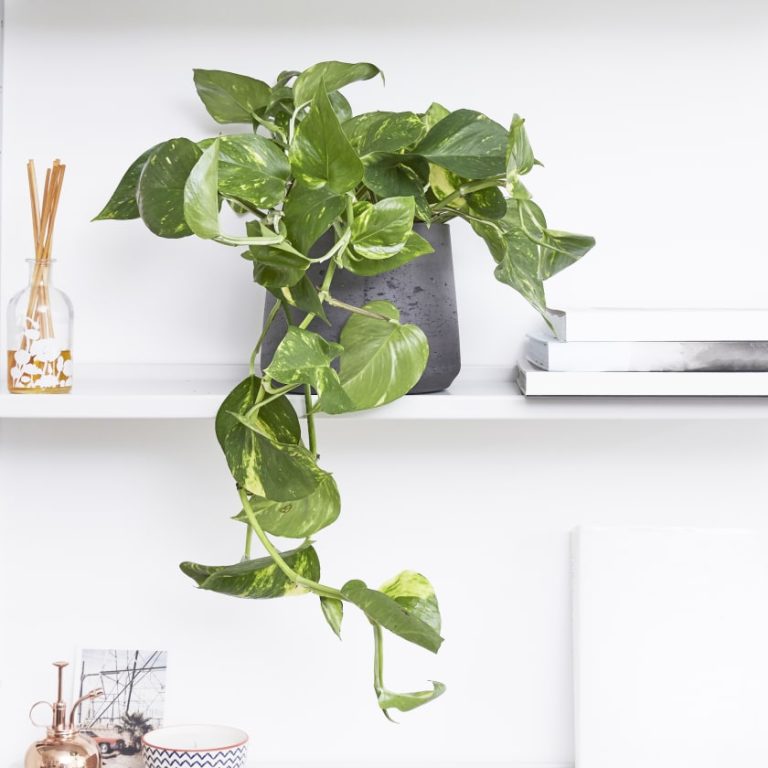
Source: Patch Plants
There’s probably no better plant that’s suitable for low-light and artificial light office conditions than Pothos Plant, otherwise known as Devil’s Ivy (Epipremnum aureum). Pothos is a notoriously hardy specimen, and will rarely bother you with plant problems, making it a really good plant companion for your dark desk or cubicle.
However, if you really wanted to kill it as some kind of nasty revenge, you would deprive it of water, which is the only thing that may cause stunted leaf growth and wilt. Excessive watering isn’t favored as well, but the plant loves to be heavily watered – it can even be grown in water – and other than that it’s very low-maintenance.
Care guide:
Water heavily, allowing water to leach through the soil, dry out only in the top two inches of soil; grows best in room temperatures of 70 to 90 F; does well in bright indirect light as well as low light.
8. Flamingo Lily
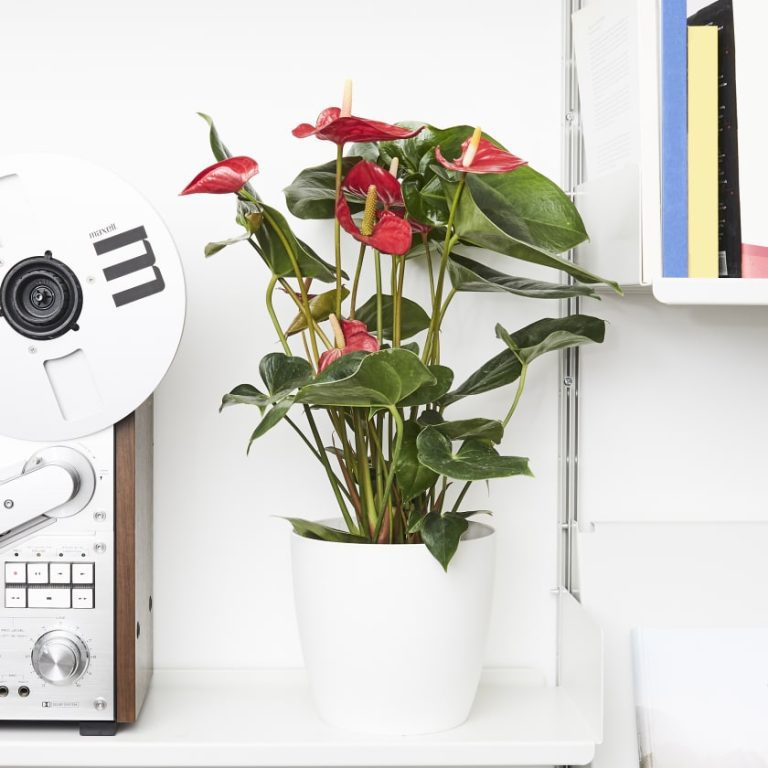
Source: Patch Plants
Painter’s Palette, Flamingo Lily, or simply – Anthurium (Anthurium andraeanum) also makes the list of the best air-purifying plants out there. Also, it’s absolutely gorgeous. Also, it’s easy to care for. However, you still have to provide a few key elements for the plant to thrive. Anthurium plants can tolerate all levels of indirect light, but if placed in low light it will have fewer flowers. Direct light, on the other hand, can be detrimental just like too many other air-purifying plants.
In terms of watering, it doesn’t differ much from the other low-maintenance plants we’ve discussed in this list – water it regularly, when the soil is dry to the touch, and don’t overwater it. Once you ensure that it’s placed in the right kind of environment, this plant will reward you with beautiful, long-lasting flowers in various shades from light pink to bright red.
Care guide:
Water moderately, when the soil is a little dry; loves indirect light; fertilize a little once in three-four months, if needed.
9. Chinese Evergreens
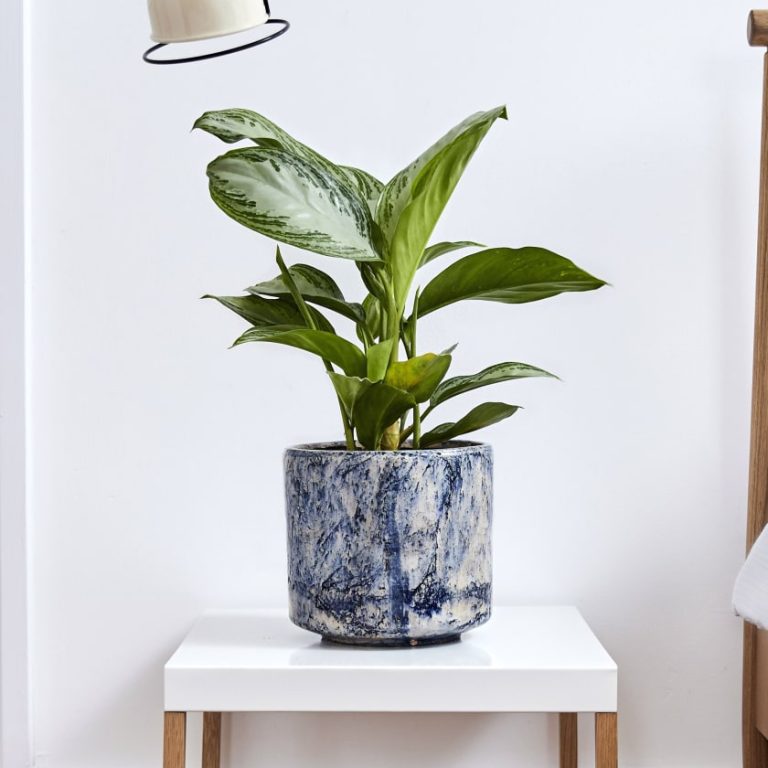
Source: Patch Plants
Before you pick out the best low-effort plant for your desk, don’t make your decision yet before hearing about Chinese Evergreen (Aglaonema modestum). Now, this tropical foliage plant can make any office worker look like a gardening expert – it’s just that easy to care for! It’s probably one of the most durable houseplants you can grow in your office, tolerating such conditions as poor light, dry air, and drought – common in many workspaces.
Chinese Evergreen becomes a truly effortless plant when given the proper growing conditions. Ideally, if you place your Chinese Evergreen in medium to low light with a room temperature of 60-72 F, but this bright fella, if necessary, will endure even temperatures of 50-55 F. Water it moderately, give it some love, and it will purify your office air free from all the chemicals in turn!
Care guide:
Water moderately, allow it to dry out a bit between watering; loves medium to low light, or indirect light.
Some final words
To conclude, all plants require care – it’s a give-and-take relationship. Some plants are surely easier to care for, some have more specific needs that need to be met if you want them to thrive and purify the air in your office. But if you don’t have a green thumb and you really want to bring in some greenery on your office desk, don’t let it be another sad story of dead leaves. Simply follow our guide and pick yourself a plant that is low-maintenance and that is easy to care for, considering the busyness of your schedule.
- Improved Air Quality: Plants absorb common office pollutants like benzene, formaldehyde, and trichloroethylene, leading to a cleaner and healthier work environment.
- Enhanced Well-being: Studies suggest improved focus, reduced stress, and boosted employee morale in offices with plants.
- Increased Humidity: Plants add moisture to the air, which can help combat dry skin and respiratory irritation, especially in winter.
- Light Availability: Not all plants have the same light requirements. Consider the natural and artificial light in your office.
- Maintenance Needs: Choose plants that fit your level of caregiving commitment. Some require more frequent watering or misting than others.
- Toxicity: If you have pets, be mindful of choosing non-toxic plants for their safety.
- Space Constraints: Consider the size and growth patterns of the plants to ensure they fit comfortably within your office space.
Place them strategically throughout the office for maximum air filtration. Consider areas with high foot traffic or near potential sources of pollutants like printers or copiers.
















